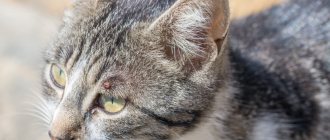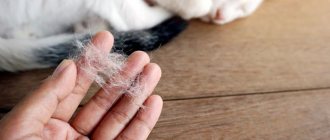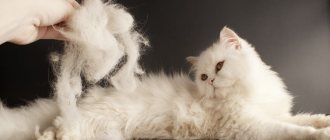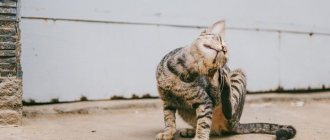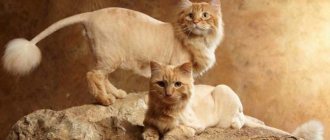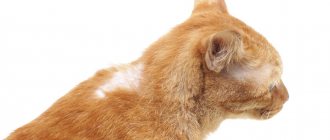12955Administration
4
It's a big decision to get a pet. Thus, we take responsibility for his well-being. But what if we encounter problems, for example, a cat’s fur is falling out in clumps, what should we do and how to help our pet?
What you are now faced with is not much like ordinary shedding, in which everything in the house is covered with an even layer of hair that has fallen from your cat. Now the wool is found in clumps. And you can often observe that this fur has come out along with part of the skin. Another unusual point is that the cat has bald patches here and there. And the skin turned red or scales or sores appeared on it.
© shutterstock
What are we dealing with? What kind of disease is this? Can we help our cat on our own? And should you seek help from a veterinarian?
Eosinophilic granuloma
Eosinophilic granuloma is an inflammatory disease of the oral mucosa and skin. As a rule, it occurs due to insect bites - fleas, mosquitoes or an allergic reaction to food components.
Symptoms:
- Single swollen areas in the oral cavity.
- Redness and swelling of the skin.
- Baldness at the site of redness.
- There is no pain or itching.
— Local lymph nodes swell.
- If lesions have developed in the mouth, the animal cannot eat and drink normally, and therefore signs of exhaustion and dehydration quickly increase.
Treatment:
Granuloma can only be cured with hormones, since there are no other means for this.
1. A course of antibiotic therapy.
2. Antihistamines, which can help in almost all cases, as they effectively relieve itching. This treatment is available at home, but you should still consult your veterinarian first.
3. Immunosuppressants such as cyclosporine or chlorambucil. They are useful if granuloma has developed against the background of autoimmune diseases.
4. Prescription of hydrocortisone. This drug also belongs to the hormonal category, but its use does not cause dangerous side effects.
============================================================================================================================================================================================
Your cat's fur is falling out: what to do?
First of all, it is necessary to analyze the situation, what lifestyle changes could provoke the situation: the food was changed, there was contact with other animals, potential carriers of infections, a child or another pet appeared in the house, which could cause stress, is it time for seasonal molting.
A growing kitten at 5-12 months actively changes its child's fur coat to an adult's one, this is normal. It is important to note the pet’s condition if it maintains its usual activity, is playful, eats well, its eyes and mucous membranes are healthy, clean, and there is no reason to worry.
If, along with the loss of fur, the cat experiences itching, scratches the skin until wounds, refuses to eat, the ears are red, the eyes turn sour, an urgent visit to the veterinary clinic is necessary.
Dermatomycoses
Dermatomycoses are infectious zooanthroponotic diseases with characteristic lesions of the skin and its derivatives, caused by pathogenic dermatophyte fungi.
Among animals, the most common are: trichophytosis, microsporia, scab.
Microsporia and trichophytosis are combined under one common name “ringworm”.
Symptoms:
- With microsporia - the appearance of limited spots of peeling and the formation of crusts on the skin of the paws, muzzle, and torso. The hair in the affected areas is sparse and breaks off easily. Lesions can be focal or disseminated.
- In cases of trichophytosis, sharply limited foci with broken hair and a flaky scaly surface or areas of inflamed skin and its follicles form on the skin in the area of the head, neck, torso, base of the tail and limbs.
Treatment:
1. When choosing medications, special increased skin sensitivity should be taken into account, and therefore it is necessary to give preference to products that have minimal irritating and cauterizing effects: Vaganova ointment (Lysol - 30.0; birch tar - 50.0; sulfur color and ASD, fraction 3—100.0 each; petroleum jelly—800.0), SK-9—chlorinated turpentine (200–500 ml per 10 liters of water), ROSC preparation, trichocetine (in the form of 2% liniment), phenothiazine (5% fish oil solution).
2. For disseminated lesions, the use of the antibiotic griseofulvin is indicated. It is prescribed orally at a dose of 2 mg per 1 kg of animal weight for 8-15 days.
============================================================================================================================================================================================
Flea dermatitis
Flea dermatitis is an inflammation of the skin caused by flea bites and an allergic reaction to their saliva. The severity of symptoms does not always depend on the number of parasites; sometimes one bite is enough for an intense pathological process.
Symptoms:
- Constant itching leading to scratching.
- Hair loss and the appearance of small nodules, most often on the back, lower back, sacrum, abdomen and thighs.
- Weeping areas in the natural folds of the skin (groin, armpits).
- Areas of redness with papules that subsequently crust over
- Hyperpigmentation.
- Often scratches become contaminated with pathological microflora, causing bacterial or fungal infections that aggravate the animal’s condition.
- The cat behaves restlessly, and in severe cases the appetite worsens.
Treatment:
1. Treat the animal with antiparasitic agents - drops, spray, shampoos. D
2. To kill fleas in the environment, insecticide solutions are used to wash bedding and rugs, wash floors, paying special attention to cracks and the space under baseboards.
3. To prevent scratching, put a protective collar on the cat and trim its claws. If the animal's itching was caused only by discomfort from flea bites and was not complicated by scratching or secondary infection, then no additional treatment is required.
In case of development of an allergic reaction and the presence of complications, the following drugs are additionally prescribed:
- Corticosteroid hormones are the main remedy for eliminating itching and inflammation in flea dermatitis. They are used both systemically and in the form of local forms (shampoos, ointments). In case of secondary infection, they are not used; in extreme cases, occasional use in small doses is allowed, mainly in the form of local forms.
- For severe itching and anxiety, sedatives are used.
- Drying agents - prescribed when there are wet areas of the skin.
- Antibacterial and antifungal agents - for minor scratching, they are used in the form of combined local preparations (for example, Sanoderm). When a secondary infection develops, systemic forms are prescribed.
- Multivitamin complexes with biotin and fatty acids accelerate the restoration of skin and coat.
If there is significant damage to the skin, it is advisable to trim the cat. This will make it easier to care for and heal scratches, and subsequently uniform and healthy hair will grow back.
============================================================================================================================================================================================
What to do if your cat is severely bald
The problem with hair loss in a pet manifests itself very clearly - tufts of fur scatter throughout all rooms, small hairs stick to clothes and fleecy furniture. To make a diagnosis, you should first pay attention to the behavior of the pussy. If the animal remains active and cheerful and does not suffer from loss of appetite, most likely the cat is simply experiencing seasonal shedding.
Reasons to consult a doctor may be:
- Changes in the cat's behavior: aggressiveness, apathy, constant need to lick or scratch.
- Uneven hair loss, appearance of bald patches on the body.
- The appearance of blisters, redness of the skin, and the formation of keratinized scales.
- Light or black dandruff.
A visit to the doctor should not be postponed. Losing clumps of hair in a cat is not just a cosmetic problem. The cause of this phenomenon can be a serious health problem, even malignant neoplasms in the animal’s body. After conducting a full examination, taking skin and blood samples for analysis, the veterinarian will be able to make a diagnosis and determine therapeutic methods.
In case of atopic dermatitis, the animal will be prescribed strict adherence to a special diet; in case of allergies, antihistamines will be prescribed; in case of parasitic infection, measures should be taken to disinfect the cat’s body.
In less serious cases, a set of simple measures will be sufficient to restore the animal’s normal condition:
- Correcting the cat’s diet, adding foods necessary for health to the food.
- Regular hygiene procedures.
- Pet vaccination.
- Carrying out vitamin therapy.
- Creating a favorable psychological microclimate for your pet.
Scabies
The causative agents of scabies are microscopic mites that live on the surface of the skin and feed on blood and lymph.
Symptoms:
- Severe itching.
— Small papules can be found on the surface of the skin, most often localized near the ears, on the chest, abdomen, and joints.
— Focal hair loss, formation of ulcers. As a result of scratching, secondary bacterial infections occur.
Treatment:
1. Isolate the pet from household members.
2. Treat cat accessories.
3. Treat the affected areas with special ointments.
4. Give injections prescribed by your veterinarian.
5. Monitor the animal’s hygiene and do not take it out for walks until the end of treatment.
6. Provide your pet with a nutritious diet containing a sufficient amount of vitamins.
7. Carry out wet cleaning of the premises daily.
The therapy includes:
— Lime sulfur (LymDip) , a solution of which is applied once a week. A total of 6 procedures are performed. To improve contact of the medicine with the skin, the hair at the treatment site is cut. Before treating with sulfur, it is recommended to wash the cat with keratolytic shampoo.
— Ivermectin (Ivomec) is a drug that effectively relieves itching within the next 5 days after treatment. This unpleasant symptom disappears completely after a month.
— Amitraz (Mitaban) . Apply no more than 4 times every 2 weeks. Due to possible side effects, it is not recommended for use on dwarf cats, sick and elderly animals. — — Selamectin (REVOLUTION) is an avermectin drug that can be rapidly absorbed. It is completely safe, so it can be used to treat scabies in particularly sensitive animals. A single use is enough to destroy the infestation. Repeated treatment is carried out only in severe cases.
To treat mange, veterinarians often prescribe a drug called Stop Itch . It is available in the form of a suspension that has the ability to normalize the function of the skin without causing allergies. The drug is injected into the cat's mouth using a syringe without a needle.
============================================================================================================================================================================================
Preventive measures
The quality of the coat is an indicator of the health of the cat. If an animal is losing a lot of hair, it is important to notice it promptly and take action. The main measures that the owner can take to keep the cat beautiful and fluffy:
- Selection of a balanced diet. Natural food should contain all the necessary vitamins. Dry and wet food must be of high quality, specially developed in accordance with age, condition (pregnancy, castration, sterilization), concomitant disease - medicinal lines of food.
- Antihelminthic courses. Veterinarians recommend every 3 months.
- Use anti-flea collars or regular treatment with special drops.
- Mandatory vaccination.
- Elimination of foods and items that cause allergies.
- Proper care – regular brushing and grooming.
- Maintaining cleanliness in the room.
Caring for and caring for your cat will keep it healthy for a long time.
For timely detection of hidden pathologies, veterinarians recommend taking tests every year. Elderly and weakened cats with chronic diseases need to visit a veterinary clinic twice a year.
Caring for your pet will help you avoid serious illnesses. Only if you follow all the recommendations, the cat will have a beautiful, thick coat and a healthy appearance.
Demodicosis
Demodicosis is a skin disease in cats caused by the demodex mite.
Symptoms:
- Severe itching
- Focal hair loss with the formation of scales and crusts in areas of baldness. Demodicosis usually affects the head, ears and neck of cats.
- Generalized demodicosis can lead to widespread areas of hair thinning and baldness, and fluid-filled ulcers may form on the skin.
- Cats may begin to lick and groom their fur excessively, which leads to even more severe hair loss.
Treatment:
1. Bathing with anti-scabies shampoo. Bathing can be continued for 4 to 6 weeks to kill all mites as the shampoo does not affect their eggs. Treatment should continue until tests come back negative.
2. The drug amitraz can also be used, but it is toxic to cats and often leads to poisoning, so it must be used with extreme caution.
3. Take ivermectin daily or weekly for four weeks, however this is also not intended for cats and has a high risk of side effects.
============================================================================================================================================================================================
Why and when should you go to a veterinary clinic?
If a cat's hair is falling out profusely and in clumps, the first thing the owner should do is seek help from a veterinarian. Hair loss to bald spots can indicate a number of serious diseases.
Even an experienced owner will not always be able to independently determine that his pet is losing hair, because, for example, he has an endocrine disease. Only a veterinarian can do this after reviewing the cat’s hormone tests.
To establish a diagnosis, the cat needs to be examined by a doctor and undergo tests. From the place where the fur grows in clumps, they take a piece of skin for analysis and study the condition of the fur. These tests will show the overall picture of the disease and help develop treatment. Depending on the diagnosis, surgical or drug therapy is prescribed. The pet owner will only need to follow all the veterinarian's instructions.
Food allergies
Symptoms:
- Skin reaction. Itching manifests itself mainly on the face and head, ears, neck, paws and stomach.
- Hair loss. It occurs as a result of itching: the cat begins to itch, and this causes bald spots to appear on its fur - bare areas of skin.
- Wounds and ulcers. This is the next stage after the formation of bald spots, which occurs if the allergy is not treated: the animal will continue to itch. First, redness and irritation appear, in place of which painful wounds can form.
- Stomach upset. If the allergen is present for a long time in the cat’s diet, it begins to feel sick and loose stools appear.
- Edema. In the later stages of allergy development, the cat swells and has difficulty breathing.
Treatment:
1. Selection of hypoallergenic food.
2. To remove allergic reactions such as itching, drugs that have analgesic, antihistamine, decongestant and anti-inflammatory effects are used.
============================================================================================================================================================================================
What to do when your pet is shedding
Each hair is “born” from a follicle, which is in a state of activity, forming the structure of the hair. When it grows, a resting phase begins; the hair does not lengthen, but remains in place. After 4-8 months, the hair dies and falls out. The peak of fur coat change occurs in the off-season.
Walking cats become warmer for winter, and before summer their fur coat becomes thinner. Pets can change the order of “changing clothes”: in the summer the air conditioners work in the apartment, and in the winter it becomes hot.
During this period, it is necessary to scratch the cat daily with a comb suitable for the type of fur; this will reduce the amount of hair left by the pet on furniture and carpets. Long-haired breeds (Persians, Maine Coons) develop mats without regular brushing. Cats try to keep themselves tidy and groom themselves.
Fur accumulates in the stomach, which the pet will regurgitate from time to time. To prevent a large accumulation of lumps in the gastrointestinal tract and problems with intestinal obstruction, you can give your pet special food that facilitates the removal of trichobezoars, phytomins, malt paste, or plant grass for cats in a pot.
Be sure to read:
Why does a cat constantly scratch its chin: what kind of disease is it?
Atopic dermatitis
One of the types of allergies that is caused by irritating external factors: pollen, dust, synthetic detergents.
Symptoms:
- Baldness.
-Pustules on the skin.
- Itching.
Treatment:
1. The doctor can prescribe broad-spectrum antimicrobial drugs in combination with antihistamines (Chlorpheniramine, Clemastil).
2. Non-steroidal anti-inflammatory drugs are prescribed.
3. If the animal’s condition is alarming, immunosuppressants are prescribed to suppress the “independent activity” of the immune system. Cyclosporine has proven itself well.
============================================================================================================================================================================================
Treatment
Treatment of the disease is directly dependent on the cause of peeling. For vitamin deficiencies, it is enough to introduce fish oil, vegetable oils (linseed, olive), and multivitamins into the animal’s diet.
It is easy to correct the situation when mechanical and physical factors influence the animal’s skin. It is enough to create a favorable microclimate in the room where the animal is kept and prepare soft bedding for it. Treat the skin if your pet gets into a fight.
In case of infectious and parasitic diseases, internal diseases, the underlying disease must be treated. In the case of allergies, first of all, you need to eliminate the influence of the allergen on the cat’s body. This could be low-quality food, shampoos or household chemicals.
Some diseases cannot be cured and can only be maintained in remission with the right diet and medications.
Cheyletiosis
“Wandering dandruff” or cheyletiosis is caused by mites of the genus Cheyletiella. Animals develop dandruff along the spine line.
Symptoms:
- Severe itching.
- Minor hair loss, flakes, dandruff.
Treatment:
1. Injectable drugs: Pyrethrin, Fipronil.
2. Additionally, animal hair is treated with antiseborrheic shampoos. Long-haired cats need to have their fur trimmed first.
============================================================================================================================================================================================
Eczema
Eczema occurs in animals with sensitive skin. This disease is especially often diagnosed in “hairless” cats: sphinxes, elves, bambinos.
Symptoms:
- Itchy rashes, blisters, increased body temperature.
— Subsequently, the foci of infection on the skin dry out and peel off.
- In some cases, they degenerate into purulent wet wounds.
Treatment:
1. Soothing ointments and powders, as well as antibiotics and vitamins, are prescribed.
2. Dry eczema is treated with Vishnevsky ointment or naphthalan ointment.
3. Wet - zinc ointment, Lassar ointment. Before using ointments, damaged areas of the skin are treated with antiseptics: Chlorhexidine, Formalin, Miramistin.
============================================================================================================================================================================================
Acne
This bacterial infection affects the sebaceous glands. Acne in cats, just like in people, is a consequence of blockage and then inflammation of the sebaceous glands and hair follicles. The owner's attention is usually attracted to rashes located in the chin area and (less often) in the lower lip area.
Symptoms:
— Pustules all over the cat’s body.
- Black dots.
- Reddened skin bumps (papules).
Treatment:
The treatment is complex.
1. First, the animal is washed with tar soap or antiseborrheic shampoos.
2. Next, apply local antiseptics: “Chlorhexidine” or “Miramistin”.
3. In difficult cases, veterinarians prescribe local antibiotics: Mupirocin.
============================================================================================================================================================================================

